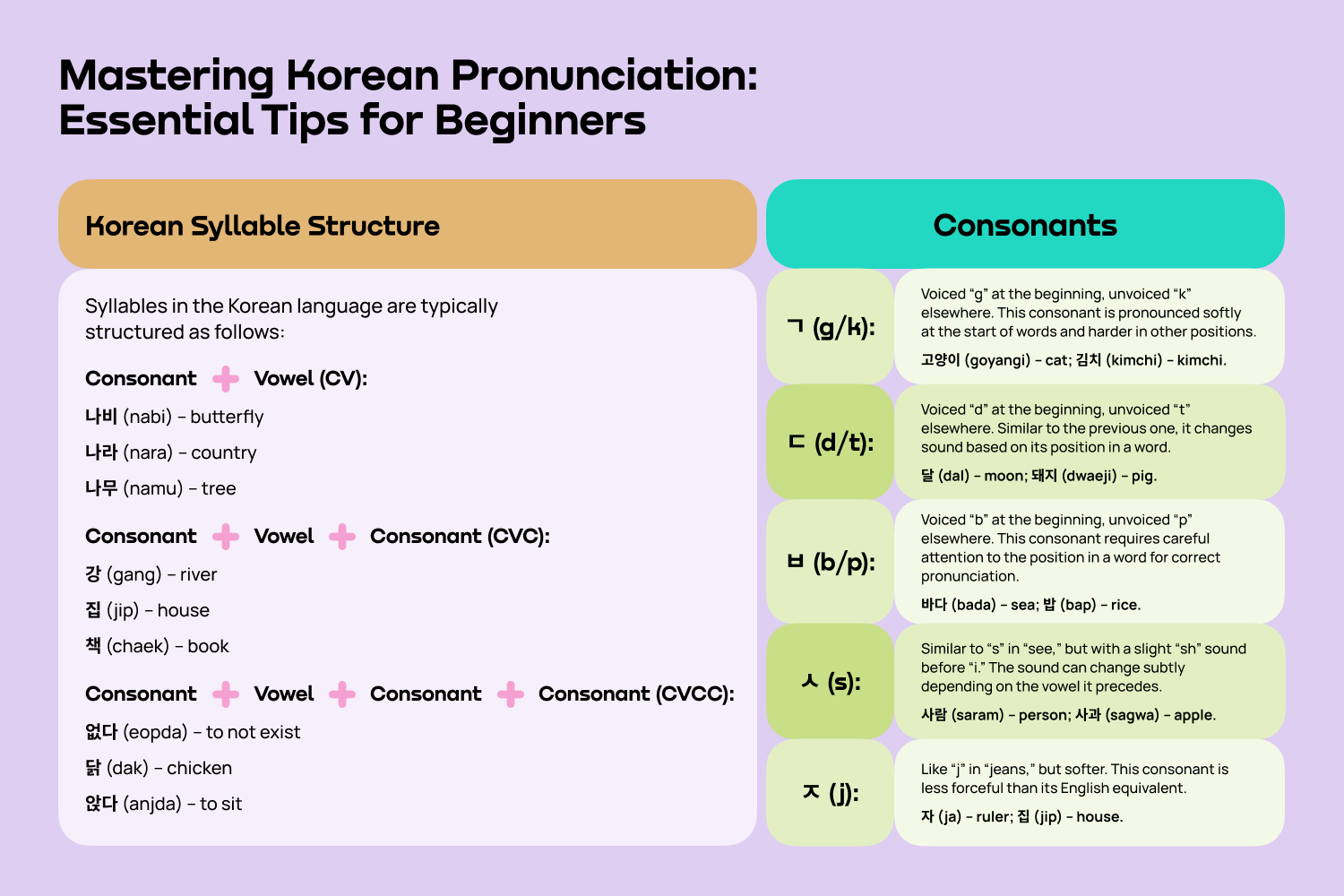Mastering Korean Pronunciation: Essential Tips for Beginners

Contents
Learning correct pronunciation is a nonnegotiable aspect of acquiring a new language. Even though it may seem challenging at first, a well-thought-out plan and regular practice can soon bring the desired results.
Unlike English, Korean pronunciation is consistent once you learn the basic rules. We have combined some essential tips to help you navigate this process:
- Study phonetics. The basics always make further learning much more effortless. Korean phonetics includes a range of sounds that may not exist in your native language. This knowledge can also help you decode unfamiliar words more easily.
- Listen actively. The theory is only useful when applied in practice. Listen to native speakers through movies, music, or podcasts. Pay attention to how they emphasize different syllables and sounds and familiarize yourself with the natural rhythm and intonation. Try to engage a variety of audio materials, as these provide different speaking styles and speeds.
- Practice regularly. Immersion is key; consistent work on your sounds helps you internalize them quicker and more effectively. Try to mimic what you hear from native speakers and focus on getting as close as possible.
- Record yourself. This often-forgotten but so important practice greatly identifies areas for improvement and speeds up language acquisition. Besides pronunciation, you can also polish your overall flow of speech. Use resources that offer feedback, especially if you’re not yet connected with natives.
Additionally, focusing on proper pronunciation from the beginning can save time and effort in the long run. Understanding the sound system will also boost your listening skills, as well as your overall communication abilities. The advice has been learned, and it’s time to dive deeper into the nuances of the Korean language.
Understanding the Unique Sounds of the Korean Language
To effectively learn how to say words in Korean, it’s important to understand the distinct sounds and how they differ from your native language. The first one requires precise articulation of both vowels and consonants, which can be challenging for English speakers due to the lack of similar sounds in their first tongue.
Korean pronunciation has unique characteristics that set it apart from other languages. Understanding these sounds is crucial for accurate pronunciation. Let’s look at each component in detail.
Korean Syllable Structure
Syllables in the Korean language are typically structured as follows:
- Consonant + Vowel (CV): 나비 (nabi) – butterfly, 나라 (nara) – country, 나무 (namu) – tree.
- Consonant + Vowel + Consonant (CVC): 강 (gang) – river, 집 (jip) – house, 책 (chaek) – book.
- Consonant + Vowel + Consonant + Consonant (CVCC): 없다 (eopda) – to not exist, 닭 (dak) – chicken, 앉다 (anjda) – to sit.
This structure is consistent across the language, making it easier to predict how to pronounce Korean words once you understand the basic patterns. Moreover, learning the role of pitch accent can further refine your pronunciation. Unlike in English, where stress is placed on certain syllables, Korean relies on pitch changes to convey meaning.
Phonetic Characteristics
- Vowel harmony: Vowels are classified into yin (dark) and yang (bright) groups, influencing verb conjugations and syllable construction. This feature contributes to the melodic quality of the Korean language. This principle means that verbs and adjectives can change their form slightly depending on the surrounding vowels, which adds a level of harmony to the language.
- Tense consonants: Some consonants are produced with greater tension, such as ㅅ (s) becoming ㅆ (ss). These tense sounds add a layer of complexity not only to Korean words pronunciation but also to their meaning, making it crucial to practice these consonants thoroughly.
- Aspiration: Consonants like ㅋ (k) and ㅌ (t) are aspirated, meaning they are pronounced with a burst of air. This feature is vital to master, as mispronunciation of aspirated consonants can lead to misunderstandings, as words can have entirely different meanings based on whether they are aspirated or not.
Navigating Korean Consonants and Vowels: A Detailed Guide
Korean has a distinct set of vowels and consonants that can be challenging for learners. At this stage, it’s vital to break down the basics and learn the main Korean pronunciation rules.
Vowels
There are ten main vowels in the Korean language, which can be combined to form complex vowels. Here are the basics of their pronunciation:
- ㅏ (a): Similar to the “a” in “mother.” The mouth is open wide, and the tongue is positioned low in the mouth.
가 (ga) – go; 사 (sa) – four.
- ㅑ (ya): Like “ya” in “yarn.” The tongue is slightly raised, and the mouth is open less than for the previous sound.
야 (ya) – hey; 이야기 (iyagi) – story.
- ㅓ (eo): Unique to Korean, like “uh” in “cut” but more open. The tongue is positioned mid-high in the mouth.
저 (jeo) – that ; 먹다 (meokda) – to eat.
- ㅕ (yeo): Like “yu” in “yum” but shorter. The mouth is more closed, and the tongue is slightly raised.
겨울 (gyeoul) – winter; 여자 (yeoja) – woman.
- ㅗ (o): Like “o” in “slow.” The lips are rounded, and the tongue is mid-high.
오 (o) – five; 보다 (boda) – to see.
- ㅛ (yo): Like “yo” in “yoga.” The lips are rounded, and the tongue is slightly higher than for the previous sound.
요리 (yori) – cooking; 효도 (hyodo) – filial piety.
- ㅜ (u): Like “oo” in “good.” The lips are rounded, and the tongue is positioned high in the mouth.
우유 (uyu) – milk; 주다 (juda) – to give.
- ㅠ (yu): Like “yu” in “yule.” The lips are rounded, and the tongue is positioned high.
유리 (yuri) – glass; 휴가 (hyuga) – vacation.
- ㅡ (eu): Unique to Korean, pronounced with a relaxed mouth. The tongue is positioned low and towards the back of the mouth.
흙 (heuk) – soil; 으다 (euda) – to scream.
- ㅣ (i): Like “ee” in “see.” The tongue is high and towards the front of the mouth.
이 (i) – two; 기 (gi) – flag.
7
Consonants
Korean consonants can be divided into three categories – plain, tense, and aspirated. Let’s take a close look:
| Consonant | Plain Sound | Tense Sound | Aspirated Sound |
| ㄱ (g/k) | 가 (ga) | 까 (kka) | 카 (ka) |
| ㄷ (d/t) | 다 (da) | 따 (tta) | 타 (ta) |
| ㅂ (b/p) | 바 (ba) | 빠 (ppa) | 파 (pa) |
| ㅅ (s) | 사 (sa) | 싸 (ssa) | - |
| ㅈ (j) | 자 (ja) | 짜 (jja) | 차 (cha) |
Pronunciation rules for consonants are pretty straightforward, so with a bit of regular practice, you can master them quite quickly.
- ㄱ (g/k): Voiced “g” at the beginning, unvoiced “k” elsewhere. This consonant is pronounced softly at the start of words and harder in other positions.
고양이 (goyangi) – cat; 김치 (kimchi) – kimchi.
- ㄷ (d/t): Voiced “d” at the beginning, unvoiced “t” elsewhere. Similar to the previous one, it changes sound based on its position in a word.
달 (dal) – moon; 돼지 (dwaeji) – pig.
- ㅂ (b/p): Voiced “b” at the beginning, unvoiced “p” elsewhere. This consonant requires careful attention to the position in a word for correct pronunciation.
바다 (bada) – sea; 밥 (bap) – rice.
- ㅅ (s): Similar to “s” in “see,” but with a slight “sh” sound before “i.” The sound can change subtly depending on the vowel it precedes.
사람 (saram) – person; 사과 (sagwa) – apple.
- ㅈ (j): Like “j” in “jeans,” but softer. This consonant is less forceful than its English equivalent.
자 (ja) – ruler; 집 (jip) – house.

When it comes to Korean to English pronunciation, one need to pay attention to the subtleties in sound production. For example, consonants like “ㄹ” can be challenging as their sound depends on the position in a word. Similarly, the Korean vowel “ㅡ” has no direct English equivalent, making it tricky for learners. To get around this difficulty, reading practice is effective, along with notes for further learning.
Common Pronunciation Challenges and How to Overcome Them
We may confidently say that every language comes with its own set of hurdles for learners. What to say about how to pronounce Korean words. The first thing to do to minimize any difficulties in your Korean studying path is to learn the IPA (International Phonetic Alphabet). It significantly helps with accurate pronunciation, especially when it’s your first Eastern language. Make sure to seek feedback; a tutor or language exchange partner can help you correct mistakes and work through complicated moments.
Forewarned is forearmed. Here are some common issues you may face and tips to overcome them.
Distinguishing between similar sounds
- ㄱ (g/k) vs. ㅋ (k): ㄱ is softer, while ㅋ is aspirated. Pay close attention to the breathy quality of ㅋ.
가방 (gabang) – bag.
커피 (keopi) – coffee.
- ㅂ (b/p) vs. ㅍ (p): ㅂ is softer, while ㅍ is aspirated. The extra burst of air in aspirated sound is key.
바나나 (banana) – banana.
피아노 (piano) – piano.
Pronouncing vowels correctly
- ㅓ (eo) vs. ㅗ (o): ㅓ is more open, ㅗ is rounded. The mouth shape is vital for these vowels.
저녁 (jeonyeok) – dinner.
도서관 (doseogwan) – library.
- ㅡ (eu): Unique sound, practice with native audio. This sound requires specific tongue and mouth positioning that may take some time to master for English speakers.
음악 (eumak) – music.
그늘 (geuneul) – shade.
Aspiration and tension in consonants
- ㄷ (d/t) vs. ㄸ (tt) vs. ㅌ (t): Practice the subtle differences in the tension and breathy quality. ㄸ is tense and without a burst of air, while ㅌ is aspirated.
도서관 (doseogwan) – library.
딸기 (ttalgi) – strawberry.
토끼 (tokki) – rabbit.
- ㅅ (s) vs. ㅆ (ss): The double consonant ㅆ requires more tension and a slightly longer pronunciation.
사람 (saram) – person.
쓰레기 (sseuregi) – trash.
Consonant clusters
- Consonants at the end of syllables can be tricky, such as ㄹ (r/l) and ㅂ (b/p).
발 (bal) – foot.
입 (ip) – mouth.
Only regular practice brings success, especially when equipped with audio resources and speaking exercises. Start slow, practice minimal pairs of words that differ by one sound, and then up the level. Using visual aids, such as diagrams of mouth/tongue positions, can help in understanding how to produce Korean words.
Exercises for Korean Language Pronunciation
There are several techniques designed to help with English to Korean pronunciation. Each takes quite a short time to become part of your daily routine.
- Shadowing
Listen to and mimic the speech of native speakers as closely as possible. Start this practice with your first steps in Korean. This technique helps with pronunciation, intonation, and rhythm.
- Mouth and tongue workout
Strengthen the muscles used to pronounce Korean words without any stammering. Start with simple pairs of sounds and work on the correct tongue and mouth positions. You can find many supporting materials online in graphic and video tutorials.
- Tongue twisters
Practicing Korean tongue twisters can not only boost your confidence but, more importantly, enhance your ability to handle consonant clusters and improve your overall fluency. It’s a great misconception that tongue twisters are only suitable for advanced level as simpler examples can be found even for beginners.
- Dictation
Listen to natives and write down what you hear. This exercise helps with both listening comprehension and pronunciation in Korean. And don’t worry, it shouldn’t be those tedious lists you had to memorize in school. You can find word and expression sets on any topic that interests you and use them as a basis for your practices.
Obviously, one of the most effective methods for mastering Korean pronunciation is to engage directly with native speakers. Consistent practice, whether through language exchange programs or social networks, can significantly enhance your pronunciation skills. Engaging in regular conversation with native speakers, either online or in person, will expose you to real-life usage and help you adapt to the natural flow of the language. But even if you don’t have this option now, there’s no reason to give up learning, all thanks to modern tools.
Master Korean Language Pronunciation with Promova
Sounds done, more to go! Even though the language's pronunciation is the basis, your next steps will include grammar, vocabulary, cultural insights, and so on. Everything might seem possible once you have the proper resources. And, as always, we are here to help!
Promova application is your one-stop solution to language fluency! Our bite-sized lessons work perfectly for anyone, so a busy schedule is no longer an excuse to neglect learning. You can download our app from the Play Store and App Store. All materials are thoroughly crafted by language professionals.
Do you have more than Korean on your bucket list? With Promova, you can master Italian, German, Spanish, Arabic, and more. Whether you start or continue your language learning journey, install the app right now and enjoy the learning journey!
Conclusion
Mastering Korean pronunciation brings deeper cultural understanding and more effective communication. You can successfully overcome common challenges and achieve accuracy by regular practicing, learning phonetic structure, and utilizing available resources. With dedication and the right strategies, Korean fluency is closer than you could imagine.
FAQ
Why is Korean vowel pronunciation challenging?
Korean vowels include sounds not found in many other languages, such as “ㅓ” (eo) and “ㅡ” (eu). To master them, learners need to practice specific mouth and tongue positions, which sometimes require time and effort.
Are there any good resources for learning Korean pronunciation?
Websites like Forvo or Naver Dictionary can provide great Korean pronunciation guides. You may also listen to Korean music, watch films, and communicate with other learners to help each other.
How important is it to learn IPA for Korean?
The International Phonetic Alphabet provides a standardized method for understanding and practicing pronunciation. It can significantly help learners recognize and produce sounds more accurately.
How to improve Korean word pronunciation quickly?
You know the drill, practice makes perfect. Add simple activities to your daily routine – you can listen to audio resources, record yourself, and get feedback from a tutor or native speaker. Incorporate pronunciation drills into your daily routine and make use of flashcards to practice tricky sounds.



Comments